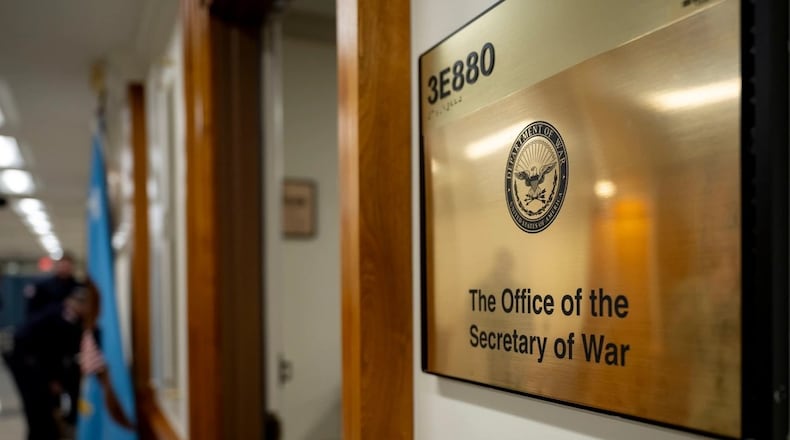According to a department statement, the order authorizes Defense Secretary Pete Hegseth and DOD/W subordinate officers to use secondary titles like “Department of War,” “secretary of war” and “deputy secretary of war” in public communications, official correspondence, and in certain ceremonial contexts.
“Defense alone is not enough; we must be ready to strike and dominate,” Pentagon Press Secretary Kingsley Wilson said in a video on the new name.
Both the new and old names appear to be in currency as everyone adapts.
On the same day as the executive order was announced, the department issued a press release about a grant to a Yuma, Ariz. school district, a release referring to the “Department of Defense.”
Also on Friday, the 88th Air Base Wing at Wright-Patterson Air Force Base issued a release about a new construction entrance to the base’s Area B off National Road.
The release referred to “Enhanced Use Leases” — basically development agreements between private businesses and the federal government — as “becoming a key tool for the Department of Defense.”
Congress possesses legislative power, and Congress has not yet voted on the name change. Presidential executive orders apply only to the executive branch, and they remain in force until they are revoked or modified. Presidents routinely end or modify orders issued by predecessors.
“Executive orders don’t carry the same weight or permanence as legislation,” noted Mark Caleb Smith, a professor of political science at Cedarville University. “Just as executive orders can be brought into the world with just the president signing a document, then the next president or the next administration can sign a document saying the opposite thing.”
Smith said he understood the distinction between primary and secondary names. But he added that he thinks the department has “underlying needs” that a name change will not address.
“It’s just rebranding. I don’t think it’s a substantive change. There’s no additional funding for the military. There’s no additional weapon systems or capability for the military,” he said, adding:
“I think it’s a lot of sizzle and no steak.”
Thank you for your attention to this matter. 🇺🇸 pic.twitter.com/aRKOmts1EK
— Warren Davidson 🇺🇸 (@WarrenDavidson) September 7, 2025
Trump, in his executive order, noted the history of the department’s name. On Aug. 7, 1789, President George Washington signed into law a bill creating the Department of War.
A merger with the Navy Department and the then-new Department of the Air Force led to the “National Military Establishment” in 1947, which became the Department of Defense in 1949.
“The founders chose this name to signal our strength and resolve to the world,” Trump’s order states. “The name ‘Department of War,’ more than the current ‘Department of Defense,’ ensures peace through strength, as it demonstrates our ability and willingness to fight and win wars on behalf of our nation at a moment’s notice, not just to defend.”
Republican senators Mike Lee, of Utah, and Rick Scott, of Florida, and a GOP House member, Greg Steube, of Florida, introduced legislation last week proposing to make the name change permanent, Reuters news service reported.
About the Author


